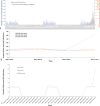Daily activities change is linked to acute angle closure occurrence in COVID-19 co-infected patients
- PMID: 39719621
- PMCID: PMC11667840
- DOI: 10.1186/s12886-024-03769-z
Daily activities change is linked to acute angle closure occurrence in COVID-19 co-infected patients
Abstract
Objectives: To analyze the influence of daily activity-related factors associated with COVID-19 infection on the occurrence of acute angle closure (AAC).
Methods: A multicenter hospital-based study was conducted at 23 ophthalmic centers in 17 provincial-level regions across China to recruit patients with confirmed AAC during the post-lockdown time of COVID-19 (P-TOC) from Dec 7, 2022, to Jan 17, 2023, and three lockdown time of COVID-19 (TOC) periods, which included the TOC-2022 (Sep 7, 2022 - Dec 6, 2022), TOC-2021(Sep 7, 2021 - Jan 6, 2022) and TOC-2020 (Sep 7, 2020 - Jan 6, 2021). Patient information, including demographic, a questionnaire on daily activity changes during the AAC period, COVID-19 history, and eye examination results, was collected.
Results: The study involved 3216 AAC cases, with 76.2% being female and 78.9% aged over 60 years. AAC occurrences during P-TOC was nearly tripled compared to the corresponding months in TOC-2021 and TOC-2020. Patients with AAC comorbidity and COVID-19 had significantly higher water intake (37.3% vs. 2.2%, p < 0.001) and poorer sleep quality (49.16% vs. 4.07%, p < 0.001) than those without COVID-19 comorbidity, while about 58.4% of these patients received antipyretic analgesic drugs for symptom management. The COVID-19 group showed higher intraocular pressure as well as worse uncorrected distance visual acuity, when compared to non-COVID-19 patients.
Conclusions: The relationship between AAC occurrence and daily activity factors associated with COVID-19 suggests that patient management should account for changes in daily activities.
Keywords: Acute angle closure; COVID-19; Daily activity.
© 2024. The Author(s).
Conflict of interest statement
Declarations. Ethics approval and consent to participate: The study followed the tenets of the Declaration of Helsinki and was approved by the Ethics committee of the Eye Hospital of Wenzhou Medical University Institutional Review Board (2023 Science Ethic No.13). Patient informed consent was waived for this retrospective non-interventional study in accordance with Chinese regulations. Consent for publication: Not applicable. Competing interests: The authors declare no competing interests.
Figures



References
-
- Tham YC, Li X, Wong TY, et al. Global prevalence of glaucoma and projections of glaucoma burden through 2040: a systematic review and meta-analysis [J]. Ophthalmology. 2014;121(11):2081–90. - PubMed
-
- China Focus. COVID-19 response further optimized with 10 new measures [Z]. 2022.
-
- TAG-VE statement on the meeting of 3 January on the COVID-19 situation in China [Z].
Publication types
MeSH terms
Grants and funding
LinkOut - more resources
Full Text Sources
Medical
Research Materials

